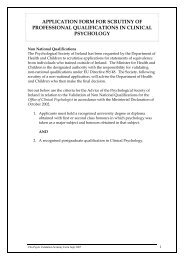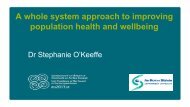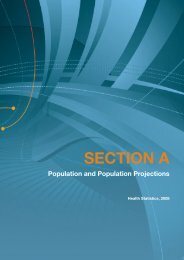Brennan Report - Department of Health and Children
Brennan Report - Department of Health and Children
Brennan Report - Department of Health and Children
Create successful ePaper yourself
Turn your PDF publications into a flip-book with our unique Google optimized e-Paper software.
<strong>Report</strong> <strong>of</strong> the Commission on Financial Management <strong>and</strong> Control Systems in the <strong>Health</strong> Servicenumbers. This sanctioned total, expressed in wholetime equivalents, is intended to relate to 31December <strong>of</strong> the year in question <strong>and</strong>, hence, is verifiable by reference to the annual Census <strong>of</strong><strong>Health</strong> Service Employees, which the <strong>Department</strong> <strong>of</strong> <strong>Health</strong> <strong>and</strong> <strong>Children</strong> takes on that dateeach year.The <strong>Department</strong> <strong>of</strong> Finance indicated to us that it views the mechanism it uses for deriving theceiling for authorised staffing levels as crude. The authorised numbers are not analysed by eitheremploying source (e.g. health boards, hospitals etc.) or by grade. However, the underlyingweaknesses <strong>of</strong> the methodology are substantially compounded by the inadequacies <strong>of</strong> the basedata used to determine the sanctioned level <strong>of</strong> staffing (i.e. the annual Census <strong>of</strong> <strong>Health</strong> ServiceEmployees).While recognising the serious weaknesses in the methodology used to calculate theemployment numbers ceiling, we are, nonetheless, concerned at the significant breaches <strong>of</strong> this<strong>of</strong>ficially endorsed figure by the health service employers, as illustrated Chapter 2.Ultimately, however, an employee numbers ceiling is a crude tool that does not reflect thecomplex management decisions on use <strong>and</strong> substitution <strong>of</strong> resources, whether labour orotherwise, which influence output <strong>and</strong> value for money. In the longer term, we see activemanpower planning (including recruitment policies, rostering arrangements etc.) as part <strong>of</strong> theongoing function <strong>of</strong> the Executive proposed in Chapter 3. This should render crude, high-levelemployee numbers ceilings unnecessary.In the meantime, a numbers ceiling must recognise the reality <strong>of</strong> service delivery if it is to beuseful as a control tool – it is the number <strong>of</strong> hours worked, <strong>and</strong> when they are worked, thatdrive pay rather than the number <strong>of</strong> people that work them. There may, accordingly, beinstances where it can be cheaper to take on extra staff on a temporary basis rather th<strong>and</strong>eliver services through overtime etc. We accept, however, that until accurate data onmanpower hours is available, a numbers policy must act as a proxy.We consider that the following actions are essential to strengthen the employment controlfunction in the health service, consistent with the regulatory role <strong>of</strong> the <strong>Department</strong> <strong>of</strong> <strong>Health</strong><strong>and</strong> <strong>Children</strong>.Recommendations on Staffing LimitsR7.8 The <strong>Department</strong> <strong>of</strong> <strong>Health</strong> <strong>and</strong> <strong>Children</strong>, in consultation with the <strong>Department</strong> <strong>of</strong> Finance, should obtain from thehealth board CEOs accurate numbers <strong>and</strong> associated costs <strong>of</strong> employment (in respect <strong>of</strong> both their ownemployees <strong>and</strong> employees funded by the health boards) to inform the appropriate authorised limit.R7.9 The <strong>Department</strong> <strong>of</strong> Finance <strong>and</strong> the <strong>Department</strong> <strong>of</strong> <strong>Health</strong> <strong>and</strong> <strong>Children</strong>, with expert assistance as required,should fully review the existing methodology applied by the <strong>Department</strong> <strong>of</strong> Finance in calculating the numbersceiling. The methodology should be based on data from health boards <strong>and</strong> have regard to the lessons learnedfrom costings produced as part <strong>of</strong> the "benchmarking" process <strong>and</strong> to the potential future information flowsgenerated by investment in information technology (see Chapter 10 recommendations on PPARS).96
















